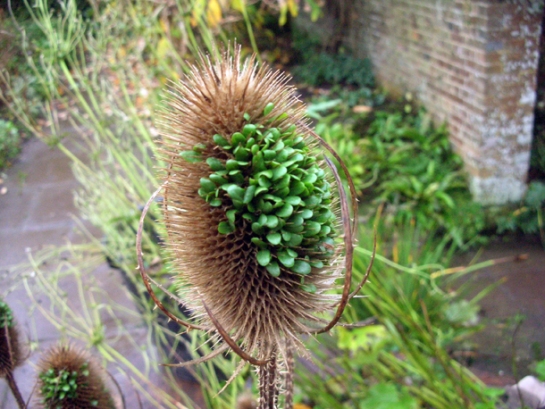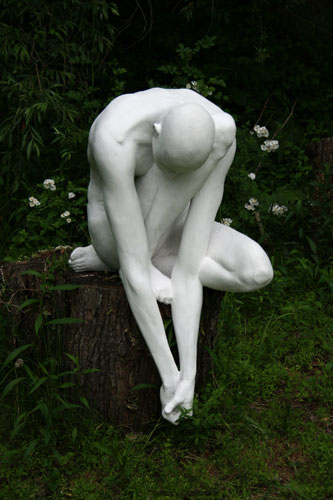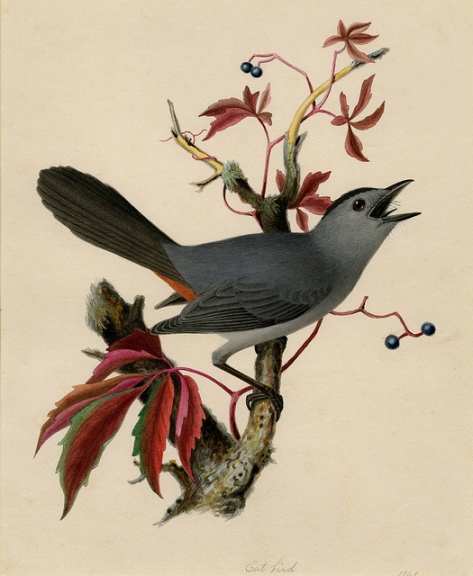GRAPEVINE: Botanical Names, Pepper Seeds, Glowing Trees, Dead Mosquitoes, Golden Lace, Sexy Lettuce, Prehistoric Fertilizer, Buck Roses, Living Fences, Defining Diversity, Healthy Weeds, Alhambra Tour, Dying Regrets

Seeds of Dipsacus fullonum, aka Teasel, sprouting within the seedhead. Photo by Maggie Tran. Click image to link to her blog, “A Year at Great Dixter.”
“Go see gardens. Every garden you can. Absorb from them what seems pertinent. Take home what works, and do better.” – Deborah Silver
– How to Pronounce Botanical Names
Relax! The good news is there is NO “correct” way to pronounce them! You may pronounce them any way you wish, and you will be just as “correct” as any Ph.D. botanist.
J. L. Hudson, Seedsman
– Saving chilli pepper seeds to grow again
To ensure the best chances of obtaining viable seed, you must ensure that the pods selected have fully ripened, before harvesting the seed. It may take several months for a pod to mature.
The Chileman
– Creating a New Kind of Night Light: Glow-in-the-Dark Trees
San Francisco-based entrepreneur Antony Evans has come up with a radical idea for curbing power usage: “What if we use trees to light our streets instead of electric street lamps?”
Smithsonian
– Why Don’t We Just Kill All the Mosquitoes?
Don’t have type O blood, don’t be a large person, don’t exhale, don’t exercise, don’t get hot, don’t be pregnant, don’t drink even one beer, don’t have parents who got a lot of mosquito bites when they were your age, and don’t wear bright clothing or otherwise call attention to yourself.
The Atlantic
– One Plant, Three Seasons: Patrinia scabiosifolia
Is it possible for any gardener to have just one favorite plant? For most of us, I imagine, it’s tough to get closer than a top 5 or top 10. But if you asked me that question at this time of year and insisted on one top pick, I wouldn’t hesitate to choose Patrinia scabiosifolia.
Hayefield
– When Lettuce Was a Sacred Sex Symbol
Lettuce has been harvested for millenia—it was depicted by ancient Egyptians on the walls of tombs dating back to at least 2,700 B.C. The earliest version of the greens resembled two modern lettuces: romaine, from the French word “romaine” (from Rome), and cos lettuce, believed to have been found on the island of Kos, located along the coast of modern day Turkey.
Smithsonian
– Stone Age Farmers Showed Sophisticated Use of Fertilizers
As early as 8,000 years ago, Stone Age farmers across Europe were working their crop lands intensely, irrigating and strategically applying manure, according to new research published in today’s Proceedings of the National Academy of Sciences. The findings also call into question previous estimates of how much protein in the Neolithic human diet was derived from animals rather than plants.
Discover
– Griffith Buck Rose Chart
I spent most of yesterday working on a talk I have to give in late September at the annual Extension Master Gardener state continuing education conference, and I put together a handout listing the Griffith Buck roses that I’m pretty proud of. …It lists what I think are all the roses (99?) bred by Griffith Buck and introduced to commerce either prior to or after his death.
Kansas Garden Musings
– Living Fences: How-To, Advantages and Tips
A living fence is a permanent hedge tight enough and tough enough to serve almost any of the functions of a manufactured fence, but it offers agricultural and biological services a manufactured fence cannot. For instance, it provides “edge habitat” that supports ecological diversity. As more species (insects, spiders, toads, snakes, birds and mammals) find food and refuge in this habitat, natural balances emerge, yielding, for example, a reduction of rodents and crop-damaging insect populations.
Mother Earth News
– Diversity Does Not Mean “Native Only.”
There is a growing body of evidence suggesting that pollinators are drawn to areas with a diverse variety of flowering plants they enjoy dining on. The National Academy of Sciences recently released a report on the matter, and the findings further underscore the importance of plant diversity for encouraging pollinator subsistence and survival. However, some have seen fit to take this evidence and create a causal relationship that the research conclusions do not: plant only native plants, as if ‘diversity’ and ‘native plants’ were one and of the same. They are not.
Prairieform
– Are Weeds Healthier Than Farmed Veggies?
…The same wild edible plants that we call weeds tend to be loaded with phytonutrients—the “arsenal of chemicals” that plants synthesize to fend off “insects, disease, damaging ultra-violet light, inclement weather, and browsing animals.” Recent studies suggest that eating phytonutrients helps humans fend off four of what Robinson calls “our modern scourges”: cancer, cardiovascular disease, diabetes, and dementia.
Mother Jones
– Tales of the Alhambra
25 years ago I made my first pilgrimage to Spain, and that was largely due to my desire to visit the Alhambra. This place was built to be extraordinarily beautiful, melding man, nature, and art in to a heavenly abode.
Jeffrey Bale
– Top Five Regrets of the Dying
A nurse has recorded the most common regrets of the dying, and among the top ones is ‘I wish I hadn’t worked so hard’. What would your biggest regret be if this was your last day of life?
The Guardian



